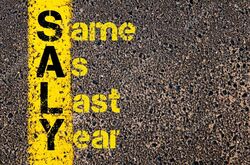Most businesses are either green and growing or ripe and rotting. Where is your business at?
Courtesy of the internet, smart phones, Google and the cloud, the way we run our businesses has changed dramatically over the past decade. Technological change continues to accelerate and you simply can’t afford to adopt the SALY (Same As Last Year) approach in business.
New technology should create efficiencies and pave the way for growth and expansion because it is designed to save time or reduce costs. It should also impact on your bottom line, however, in some cases there is a significant learning curve with new systems and technology so productivity can suffer in the transitional period.
Of course, there are the hidden costs of technology. The iPhone was released in June 2007 and today the average iPhone user unlocks their device more than 80 times a day! People struggle to unplug from these devices and staff get distracted, impacting on their creativity and productivity.
They say, if you keep doing things the same way and expect a different result, you’re insane.
The SALY approach in business could be the first sign of madness. There are countless stories of businesses who failed to adapt to change and paid the ultimate price. For example, Kodak, who once dominated the photographic film market failed to respond to the changing market and the transition to digital photography. Despite developing the first self-contained digital camera in 1975, Kodak filed for bankruptcy in 2012. Steve Sasson, the Kodak engineer who invented the digital camera, described the initial corporate response to his invention this way:
“But it was filmless photography, so management’s reaction was, that’s cute – but don’t tell anyone about it”. For people old enough to remember, that could be described as a real ‘Kodak Moment’.
Drive Your Business with a Forward Focus
No industry is immune from change and many of today’s game changing products will become mainstream very quickly. The iPhone is a great example. You can accept or reject innovation but if your business is flat lining or in decline you need to have a forward focus. Use historical data and marketing techniques as a guide, but don’t hang your hat on them.
We all know that if you drive your car looking in the rear-view mirror one of two things will happen – you’ll either lose control and run off the road or you’ll collide with the vehicle in front of you. Similarly, you can’t run your business with a focus on what’s behind you and the only real reason to glance in your rear-view mirror is to make sure your competitors aren’t gaining ground on you. You need to focus on what lies ahead including innovative technology and software that could give your business a serious competitive edge. Watch for emerging trends in your industry and monitor what your competitors are doing.
Apple claim they have always focused on ‘what it’s doing, not where it’s been’. It serves as great advice because most small business owners are focused on duplicating past successes. Unfortunately, past performance is not a reliable indicator of future performance. While it’s always nice to occasionally reflect on your past accomplishments, don’t dwell on them. Don’t get complacent but also don’t completely abandon strategies, tools and marketing techniques that are proven performers.
Marketing
Marketing has been turned on its head in the past decade. Ten years ago, sales representatives ran the show and controlled the sales process. If buyers wanted anything, they had to channel everything through a sales rep. In 2019, buyers operate in a self-service model, they go online and do their research and the sales rep role has shrivelled up in most industries. Prospective buyers only reach out to you for that last piece of information they can’t find online like the price and delivery cost.
Old marketing tactics like letter box drops, yellow pages, local paper advertising and sponsorships have lost their mojo. They simply aren’t as effective as online searches, content marketing, email marketing and social media channels. Even referrals have shifted online with customer reviews. Of course, in today’s internet fuelled world your website should be the nerve centre of your business and you can’t afford to have a website that is fundamentally an electronic brochure.
The digital transformation has seen an explosion in the breadth and depth of digital and social tools. As such, a SALY (Same As Last Year) approach to marketing is fraught with danger. Change for the sake of change is illogical but you have to adapt to the changes in consumer behaviour. Your marketing needs to target your niche markets and your ideal type of customer. Here’s some questions that serve as a great starting point:
- Who is your target market? Start by identifying your ideal type of customer.
- What demographic? Where do they live? What forms of social media do they prefer?
- What irresistible message would force your ideal type of customer to contact you?
- How will you take them through the customer journey and turn them into loyal customers?
Summary
Where is your business at? Courtesy of the internet, smartphones, Google and the cloud, the way we run our businesses has changed dramatically over the past decade.
Technological change continues to accelerate and you simply can’t afford to adopt the SALY approach (Same As Last Year) in business.
You need to focus on what lies ahead including innovative technology and software that could give your business a serious competitive edge.
You’ll get plenty of advice from people telling you that you need to be on Facebook, spend money on Google AdWords and invest in SEO and local search marketing, however, before you throw your dollars at various tactics you need to develop a marketing plan. Adopt a strategy first approach because, in business, failing to plan is planning to fail.





